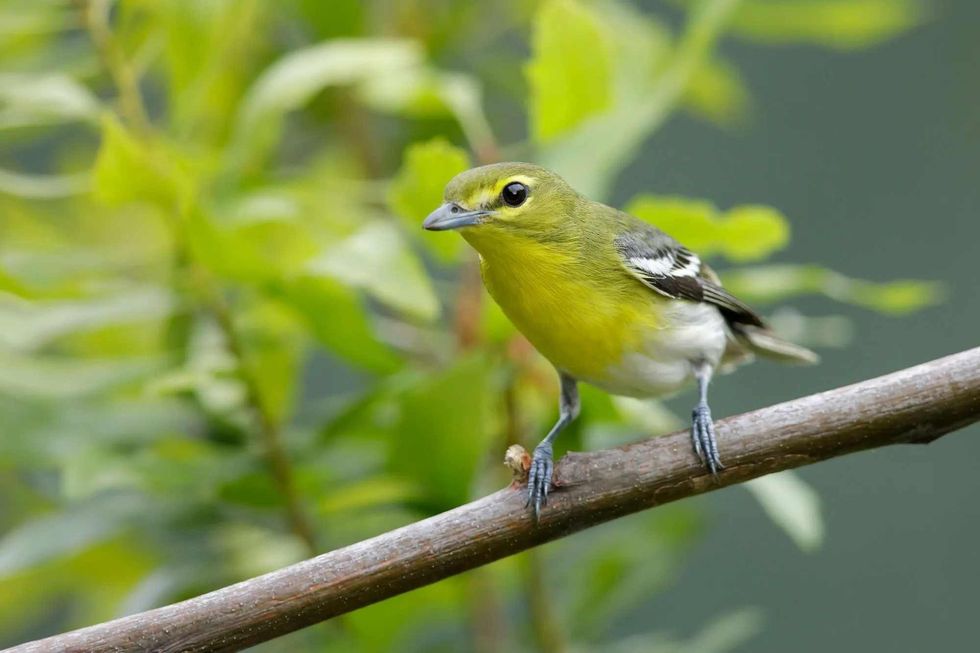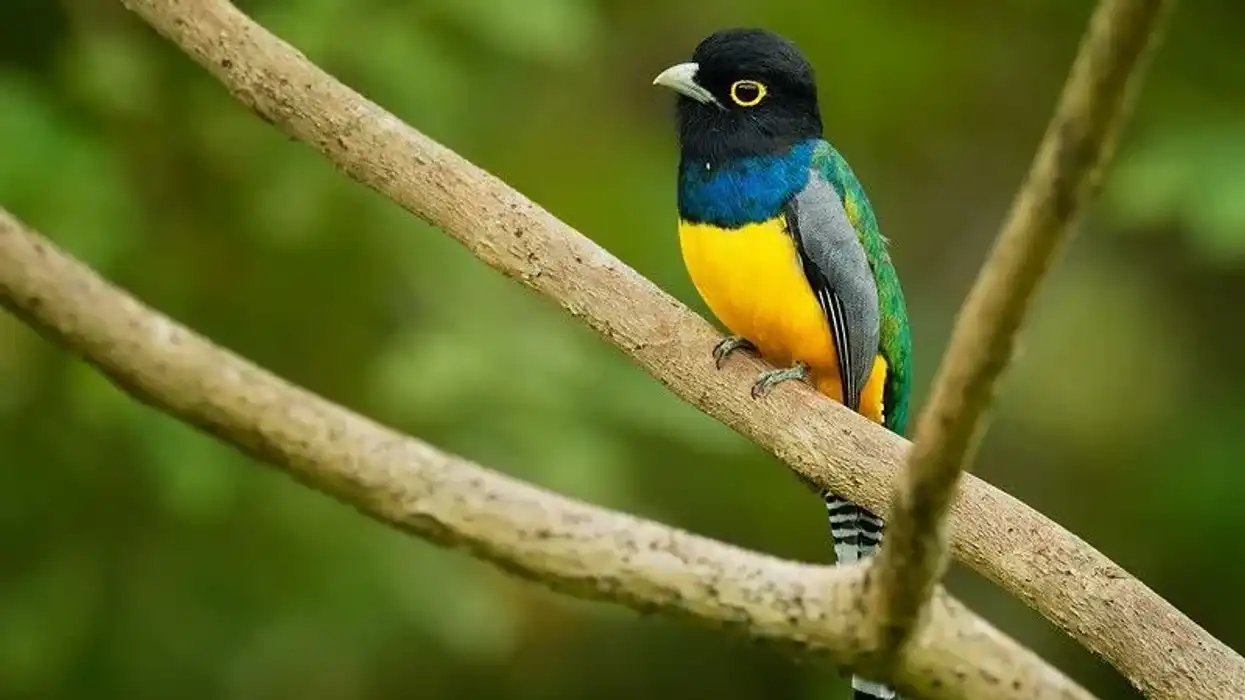The yellow-throated vireo is a bird endemic to the eastern North American continent. It is the brightest and flashiest member of the olive-gray family of vireo birds.
It is a small, mostly yellow bird that also has a yellow 'spectacle' on its face. It migrates south of its summer habitats, in the winter, mostly to Central America and northern South America.
It can get territorial in the winter with others of its species. It likes to live in big deciduous forests and tolerates human presence. The yellow-throated vireo is also found living in habitats like coffee plantations, beaches, shrubs, and cypress swamps.
It forages and flies with mixed flocks sometimes. Its songs are burry-like and broken and its calls are harsh and scolding.
It is protective of its nests which are usually on trees. It is currently a species of 'Least Concern' according to the IUCN and its world population trend shows an increasing trend.
For more relatable content, check out these black-capped vireo facts and warbling vireo facts for kids.
Yellow-Throated Vireo Interesting Facts
What type of animal is a yellow-throated vireo?
The yellow-throated vireo (Vireo flavifrons) is a bird.
What class of animal does a yellow-throated vireo belong to?
The yellow-throated vireo (Vireo flavifrons) belongs to the 'Aves' class of animals.
How many yellow-throated vireos are there in the world?
The exact number of yellow-throated vireo birds in the world is unknown, but their population shows an increasing trend.
Where does a yellow-throated vireo live?
The yellow-throated vireo is endemic to the North American continent and is found in the southern regions of Canada and the eastern regions of the United States of America. In the North American regions, it is found from the Gulf Coast states to Ontario, to Minnesota to Manitoba.
The yellow-throated vireo range also includes southern Texas, southern California, and southernmost Florida.
It is during migration that the bird moves to the deep south of the eastern United States of America and also to the Caribbean, Mexico, the Bahamas, Central America, and northern South America. Western Europe also sees some migrants.
What is a yellow-throated vireo's habitat?
The habitat that the yellow-throated vireos prefer the most is the open deciduous forests. Within the deciduous forests, these birds favor forest gaps and edges.
Yellow-throated vireos also inhabit live oak hammocks, mixed-deciduous forests, mixed turkey oak, mature pine forests, and pine woodlands. It needs large forests, more than 250 acres or 0.4 sq mi (1 sq km) in area to live and breed in.
Riverine habitats in mixed forests, streams, lakeshores and live oak hammocks also see yellow-throated vireos. While migrating, they are seen in woodlands, shrubby areas, and barrier beaches. During winter, dry tropical forests, thorn scrub, and coffee plantations are also inhabited by yellow-throated vireos. They also live in rainforests but only up to elevations of 6,000 ft (1,829 m).
Who do yellow-throated vireos live with?
Yellow-throated vireos may live alone, in pairs, or in flocks and groups. During the breeding season, they are seen in pairs.
They are not known for much interaction with others of their species but they have been seen foraging with other birds like chickadees, titmice, and warblers. They also fly in mixed flocks but are seen defending their territories in the winter.
How long does a yellow-throated vireo live?
The exact lifespan of yellow-throated vireos is not known, but like other vireos, they may live for 6-10 years.
How do they reproduce?
Yellow-throated vireos reproduce via mating and laying eggs. During the summer breeding season, the male vireos arrive at the sites before females and leave nest-building materials at various sites.
They sing and call for females. When the female vireos arrive, they are given a display of swaying and wing-quivering by the males.
If accepted by the female, pairs get formed, and the nests are completed by females with materials like grasses, moss, roots, weed stems, spiderwebs, and other herbaceous materials. The pairs mate and the females start laying eggs. The nest is usually built at a length of 3-60 ft (1-18 m) off the ground.
3-5 eggs are laid, incubated by both parents for two weeks. The chicks fledge after another two weeks and the pairs separate after that.
What is their conservation status?
The conservation status of the yellow-throated vireo species according to the International Union for Conservation of Nature is 'Least Concern'.
Yellow-Throated Vireo Fun Facts
What do yellow-throated vireos look like?
Adult yellow-throated vireos have olive-colored heads and upper parts. They are named for their yellow throats and also have white bellies and gray rumps. One of the most observable features of these birds is the bright yellow 'spectacles'.
The wings and tails have two white wing-bars and are mostly dark gray-colored. Yellow-throated vireos have a stout, slightly hooked bill which helps to distinguish them from the similar species of pine warbler birds.
They have thick legs and feet that are blue-gray in color. They also have dark eyes and eyerings that are yellow. Young juveniles look similar to adults but are overall paler and seldom have buffy throats.
How cute are they?
The yellow-throated is an adorable and extremely beautiful species of bird. It is the brightest colored bird in the vireo family. It has a yellow 'spectacle' that makes it look very smart. The white wing-bars also add to its beauty.
How do they communicate?
Yellow-throated vireos communicate via songs and calls.
The song of yellow-throated vireos consists of two-and three-syllable phrases that are burry and broken. There are pauses between these phrases that sound like 'three eight, three eight, three eight'.
They sound like other vireos but with a sore throat. Males sing from tall canopies during migration and nesting. They sing with lesser intensity after forming a pair with a female.
The call is a series of rapid 'cheh, cheh, cheh' notes which are nasal, harsh, and accelerating. The scolding chatter is heard during encounters with predators, birds, or even other vireos in winter. The higher the threat, the greater the intensity of the call.
How big is a yellow-throated vireo?
The yellow-throated vireo is 5.1-5.9 in (13-15 cm) in length with a wingspan of 9.1 in (23 cm), which makes them 2-5 times as big as the bee hummingbird.
How fast can a yellow-throated vireo fly?
Yellow-throated vireos are small birds, so it can be assumed that they fly around 20 mph (32.2 kph) or less. Their flight pattern can be described as 'direct and fluttering with the rapid beating of wings'.
How much does a yellow-throated vireo weigh?
A yellow-throated vireo weighs 0.5-0.7 oz (15-21 g).
What are the male and female names of the species?
The males and females of the yellow-throated vireo species aren't referred to by specific names. Like other birds, they're called 'cocks' and 'hens' respectively.
What would you call a baby yellow-throated vireo?
A baby yellow-throated vireo is called a 'chick'.
What do they eat?
Yellow-throated vireos are omnivores who eat insects, spiders, moths, butterflies, stinkbugs, leafhoppers, scale insects, beetles, bees, flies, fruits, and seeds.
They themselves get preyed upon by jays, crows, red squirrels, long-eared owls, Cooper’s hawks, and blue jays.
Are they dangerous?
No, yellow-throated vireos are not dangerous to humans at all, unless they feel the need to protect their eggs and their chicks. They will sound scolding alarm calls and may very rarely dive at your head when they feel their nest or young chicks being threatened.
Would they make a good pet?
No, yellow-throated vireos do not make good pets. They are small and adorable but they are wild birds at heart. They like living in huge forests and woodlands in North America and captivity would not suit them at all. They are elusive even in the wild and do not have much patience for humans at all.
Did you know...
Vireos are not known to visit many feeders. But if they were to, you should put out insect suet, cut up fruits, and mealworms.
A yellow-throated vireo is harder to find than a similar species, red-eyed vireo birds.
Warbling vireos are small and they have white upperparts and olive-gray underparts. Their sides are seldom washed yellow, their eyes are brown, and their thick eyebrows are white. They also have dark but faint eye-lines. Their wing and tail feathers are both gray, their feet and legs are blue-gray, and the bill is stout and slightly hooked.
What does a yellow-throated vireo sound like?
The yellow-throated vireo song sounds like 'three eight, three eight, three eight' and the call sounds like 'cheh, cheh, cheh'.
Do yellow-throated vireos migrate?
Yes, they do, to deep southern US, the Caribbean, Mexico, Central America, and northern South America.
Here at Kidadl, we have carefully created lots of interesting family-friendly animal facts for everyone to discover! For more relatable content, check out these saffron finch fun facts and Muscovy duck fun facts for kids pages.
You can even occupy yourself at home by coloring in one of our free printable sword-billed hummingbird coloring pages.









